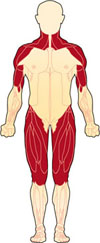Myositis Print Page
Overview
Inflammatory Muscle Diseases are autoimmune diseases which cause weakness primarily to the muscles around the shoulders and hips. The most common types are polymyositis and dermatomyositis. While it can be confused with other diseases, a proper diagnosis is vital to allow for prompt treatment.
Frequently Asked Questions

Myositis: Proximal muscle
involvement (noted in red)
What is myositis?
- Myositis is defined as inflammation of the muscles. While there are many reasons for myositis to occur, the term usually refers to the two most common autoimmune causes, polymyositis and dermatomyositis.
Why does myositis happen?
- No one really knows. There is as of yet an unidentified trigger which causes your immune system not to recognize certain cells as belonging to you. Because of this, they attack these cells, causing the clinical symptoms.
Who gets myositis?
- While myositis can affect anyone, it does affect females more often than males, and those in the ages 15-25 and 45-55.
What is the difference between polymyositis (PM) & dermatomyositis (DM)?
- Generally speaking, the most obvious difference is DM also has involvement of the skin whereas PM does not. There are a number of other small differences, but the treatment is generally the same.
How is myositis diagnosed?
- Myositis is first suspected in a person who presents to their physician feeling unwell with weakness in their proximal muscles, the muscles around the shoulders or hips, and the muscles that flex the neck forward. Pain is usually absent.
- A blood test called Creatine Kinase, or CK, is usually found to be elevated, although it is not diagnostic.
- Your physician may need to do a number of other investigations to rule out other possibilities, which may include certain medications, thyroid problems, and other rheumatic diseases.
- If myositis is still suspected, a muscle biopsy should be performed to confirm the diagnosis prior to starting treatment in most cases.

A rash on the eyelids, called a heliotrope rash.
Does myositis only affect the muscles?
- While the most common presentation is proximal muscle weakness, inflammatory muscle diseases can and do affect other organs as well.
- Skin involvement occurs in Dermatomyositis, commonly causing lesions over the eyelids, knuckles, elbows, the chest and back.
- Some patients also can become short of breath because of lung involvement, or have difficulty swallowing because of involvement of the esophagus.
Why is a muscle biopsy necessary?
- Because the therapies available to treat inflammatory muscle diseases do carry some risks, it is very important to be sure of the diagnosis prior to starting treatment. There are some less common diseases that can present similar to myositis which may be difficult to diagnose without a biopsy.
How is myositis treated?
- The main treatment option for myositis is high dose glucocorticoids (steroids). They are taken until the disease is controlled, with both strength and CK returning to normal. They are then slowly tapered down over a few months.
- Many rheumatologists will also use safer steroid-sparing medications to be able to reduce the dosage and duration of steroid use. Examples include methotrexate and azathioprine.
- Other treatment options may be necessary for those with lung or esophageal symptoms.
- Rehabilitation is also a key component to treatment. Your rheumatologist may recommend physiotherapy or a myositis education program to you.
I have heard that myositis is caused by cancer. Is this true?
- In a small minority of patients, there is a possible association between myositis and cancer, although it remains somewhat controversial. Your rheumatologist may suggest screening tests that are gender and age appropriate to ensure an underlying malignancy is not missed.
What is the prognosis for inflammatory muscle diseases?
- While most patients will do well with timely and appropriate treatment, those with delayed treatment, more severe weakness, increased age, lung involvement or an underlying malignancy have been reported to have a poorer prognosis.